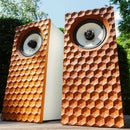Introduction: Make an Elegant Wine Glass Holder From White Oak
So I saw a thing like this on Pinterest a few months back and thought it would be interesting to hack a bit.
The one I saw was made out of some pallet wood or something and in my opinion wasn't very elegant which is what you want so it can pair nicely with he elegant shape that is a wine bottle.
So for my version I decided to use White Oak as it is what I have been using for a lot of my recent project and craft work. (I have a stockpile from a local sawmill that was just burning it!!!)
For those who are like "TL;DR" here is a vid of the design, cam, and cnc work: https://youtu.be/asxPKYLgSys
http://www.youtube.com/c/NickCharlton0 {------------ My YouTube Channel
When I optimise the design I will start selling these on Etsy too :) (see last part for why it isn't optimised)
Please vote for this Instructable in the "Host With The Most" if you liked it :)
Step 1: You Will Need:
- some wood
- a plan
- jigsaw
- drill
- router
orrrrrrr if you have a CNC then you're set!
Step 2: Design Pt-1
I started out as I do with most of my projects by drawing a little sketch to mark out some rough dimensions and get an idea of size, then I jumped into Autodesk Inventor. It is an incredibly versatile tool and I use it for all design work.
I began with the polygon tool and selected 5 sides, I knew when I started that I wanted a pentagon as 5 glasses is about the maximum you can fit around a wine bottle with a reasonable size diameter of the caddy.
I cut a 60mm hole through the middle as this should sit nicely on the filleted part of the wine bottle neck.
Next, I outlined the slot design where the glasses would sit then used the array tool to make 5 copies on the corners of the pentagon and cut them down through the model.
Step 3: Design Pt2
I then added some chamfers tot he centre hole and to the cut-outs for the wine glasses as shown in the screenshots these were just to show me what it would look like all completed as I didn't cut the chamfers on my CNC.
I then scoured through my design archives and found a model of a wine glass and a bottle that I had designed for a past project, I imported them into the assembly environment in inventor and started adding part relationships to seat the caddy on the wine bottle and the glasses in their places. Then I set the view type to 'realistic' to get a nice looking representation of what the final product will look like. Once I was happy with that I moved on to CAM.
Step 4: CAM
The next step was to take a dxf outline of the part (making sure to suppress the chamfered features before hand) and drop it into CamBam. From here I produced a inside profile cut for the centre hole and an outside cut for the perimeter and added some holding tabs.
I then generated some Gcode and saved it out after checking the visualisation of the tool paths in CamBam as shown in the picture above.
Step 5: CNC Machining
Next I loaded a piece of oak into my cnc and clamped it down firmly.
I used 1/8th inch single flute endmill for good chip ejection. The job took a while because I am having issues with my CNC at the moment; there is something not right and so its rigidity is compromised a bit. I only noticed it during the cutting of this part so I cancelled the program, slowed down the feed rates and carried on just to finish the job.
I highly recommend not doing what I did as it turned out there was a looses bolt... oops... pretty dumb of me to carry on machining...
If you have an issue stop the job immediately and don't restart until it is resolved!
Step 6: Cleaning Up the Cuts
As you can see from the picture I ended up cutting it out again on the CNC because the error I encounted in the first go caused it to cut incorrectly.
There were a few chipped edges which are caused by the oak being extremely hard and a quite blunt end mill which doesn't take good chips out of the part.
So i used a cabinet scraper just to get the edges flat prior to hand routing.
Step 7: Cutting Chamfers
I set up my router with a chamfer bit and clamped the body of the router in a bench vice to act like a router table.
I then went over all the edges with a light chamfer and then did the max chamfer that the bit could do on the holes which will seat the wine bottle and the glasses. I did this very slowly to avoid any tear-out of the wood as it was quite knotty.
for some of the edges I couldn't get the router bit to fit so i used sharp Stanley knife and a chisel to clean those up.
Step 8: Sanding
I then did a final sanding on all the sides and the faces to make it nice and smooth prior to finishing. I did the edges on a flat sheet of sandpaper on a piece of mdf to keep it nice and flat.
Then I used a sanding sponge to clean up edges and the chamfers.
then I used the sponge sander to smooth the surfaces of the wood.
Step 9: Finishing
I used a solvent based sealant called "water Seal" It helps waterproof the wood in case of any spillages. This finish also makes the grain really pop out without effecting the colour too much. It really complements the white oak I used.
I applied one coat and then let it dry for an hour and then applied another and wiped off the excess.
I was very pleased with the finish this produced it makes it super smooth and as I said before it really highlights the beautiful grain.
Step 10: Optional Step- Rubber Strip
Depending on the type of bottle you are using the caddy on it may be more or less wobbly. This isn't necessarily a problem as the caddy can hold a wine glass even when it it tilted right over to one side because of the chamfered seats for the wine glasses.
However, I wanted to experiment so I found some adhesive backed door seal and measured a length that would fit around the chamfer of the centre hole. I then cut notches along the whole length so it would bend around the circle nicely. The adhesive didn't stick well to the now finished caddy so I used some super glue.
This did make a difference on the wine bottles with a short fillet from the neck to the main body of the bottle ( the bottle with the gold foil in the pictures above) It doesn't however help with the other type of bottle pictured but as I said it can tilt all the way over without a glass falling off the caddy as pictured.
Step 11: Finished!!
I am very happy with how the caddy came out and I realised it can also double up as a tray fro carrying the glasses on their own but I guess it is designed so that you can just pick the whole thing up but the neck of the wine bottle and then carry to the table like this. Or it can be used as a centre piece for a dining table and makes a good conversation starter.
Step 12: What I Would Do Differently/ Modifciations
I think the only issue with this is it doesn't work well with all bottle types. I also ended up designing a version with a smaller hole in the middle whick did work better. I am going to experiment and find the optimal size before I make a listing for these on my etsy shop!

Grand Prize in the
Host with the Most Challenge














